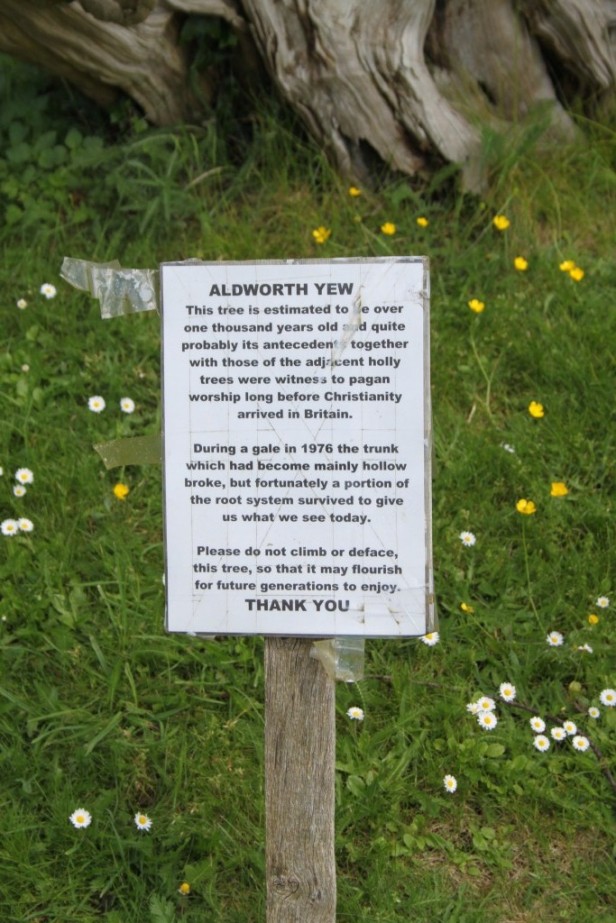
Aldworth in west Berkshire has a fabulous flint-built church on the Berkshire Downs. Outside is a fabulous churchyard with a cleared, and presumably older, southern side, and a large extended northern side in which the most recent graves are located. The most notable feature on the southern side and approach through the churchyard is the ancient yew. This is of interest not only for its claimed antiquity and focus of ‘pagan’ worship (not too sure of that), but also the fashion in which it has been kept on arboreal life support and given its own sign.


Close to the yew on the southern side are the redisplayed collection of 18th-century gravestones with their cherubs and other neo-classical ornaments.

On the eastern end of the church is the war memorial, a distinctive location for a modest memorial that I have seen at a number of churches.

Another feature of interest in the churchyard is the presence of some iron grave-markers, something which I have a particular taste for given their rarity and distinctiveness as a memorial medium during the late 19th and early 20th centuries. I cannot think of any particular reason why iron would be opted for here, other than the relative proximity of the Great Western railway allowed ready transport.


Within, the church, there are only a handful of post-medieval memorials. Instead, the entire space is dominated by the effigy tombs of the knightly de la Beche family. This collection is not particularly notable for its quality of survival; there are many better-preserved 14th-century memorials elsewhere. Yet these tombs are interesting because of:
- their number and cumulative impact on the church space.
- the possible back-projection of commemoration down the family’s generations from the mid-fourteenth century to the late thirteenth.
- the male dominance of the assemblage. This is hardly surprising, but it does serve to illustrate the selectivity and masculine focus of the commemorative programme of this Berkshire aristocratic family.
- A further point of interest lies in the tomb which may reflect the giant stature of one of the family members, posed leaning on his right shoulder rather than on his back so his legs can be bent to allow him room to fit within the niche. He has a dwarf rather than a dog at his feet. This may possibly serve to commemorate the fashion of his appearance at court with a dwarf servant to further exaggerate his height. The likelihood is that this is an idiocryncratic portrayal rather than a stylised representation, especially as it contrasts markedly with the rest of the effigies.

Giant and dwarf – the effigy attributed to Sir Philip de la Beche

Together these monuments dominate the church space and create a strong, exclusive sense of family history they could not achieve had they opted for a more prestigious burial location. These tombs have suffered in two distinctive ways. Firstly, they represent Parliamentarian iconoclasms in the seventeenth century: the limbs of many of the effigies have been hacked off. and the whole or tops of heads too. Treated like peoples, the tombs have punished in a comparable fashion to traitors. Second, many have subsequent graffiti, particularly I noticed attracted (for reasons that are not clear) the male effigies. The graffiti is not arbitrary, but is added to respond to the physical form of the human body and the knightly clothing and armour. A further point in this regard is one memorial where the graffiti – deliberately or by happenstance – serves to gouge new eyes for the effigy…
These tombs have suffered in two distinctive ways. Firstly, they represent Parliamentarian iconoclasms in the seventeenth century: the limbs of many of the effigies have been hacked off. and the whole or tops of heads too. Treated like peoples, the tombs have punished in a comparable fashion to traitors. Second, many have subsequent graffiti, particularly I noticed attracted (for reasons that are not clear) the male effigies. The graffiti is not arbitrary, but is added to respond to the physical form of the human body and the knightly clothing and armour. A further point in this regard is one memorial where the graffiti – deliberately or by happenstance – serves to gouge new eyes for the effigy…








The Legend of the ‘Aldworth Giants’
On visiting the church of St Mary’s I realized that the nine giant effigies were similar to those in the Temple Church in London and saw that, as in the case of Sir Philip De La Beche (Aldworth), the effigy had crossed legs and was therefore likely to be Knight Templar; six of the Aldworth effigies, as in London have crossed legs
When the original Knights Templar returned from excavating under Temple Mount in Jerusalem they brought back much treasure that was concealed at various locations known only to those Knights and successive Grand Masters. The secret of the treasure sites was recorded on the Chess Board which symbol became the Templar Banner. Each of the sites was symbolised by a chess piece. In the case of Sir Philip De La Beche (the elder) he is seen as the white King and goes on his black square. Lady Isabella De La Beche is the Black Queen. One of the effigies holds the key to the ‘Great Secret of the Knight Templar’.
In reality then it would appear that the same clues seen in London have been set out at Aldworth and therefore makes the story the ‘Giants’ tell all the more intriguing. There is however one other part to the story. Originally there were ten effigies at Aldworth; the tenth was in the arched recess in the south wall of the church, but was lost during renovation works. I believe it found its way to St Lawrence’s Church Hungerford where it is known as Sir Robert De Hungerford. In my opinion the Hungerford ‘Sir Robert’ is ‘identical’ to Sir Philip De La Beche (the elder) at Aldworth.
(Booklet – ‘The Aldworth Giants’ – Geoffrey Morgan)